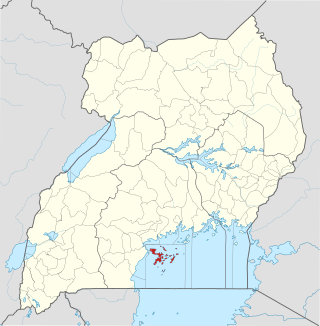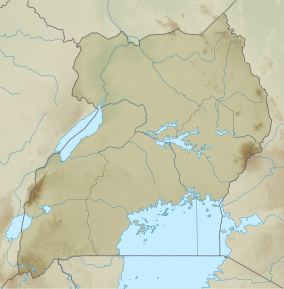
The Ssese Islands are an archipelago of eighty-four islands in the northwestern part of Lake Victoria in Uganda. The islands are coterminous with the Kalangala District in southern Central Uganda, which does not have any territory on mainland Uganda.

The Budongo Forest in Uganda is northwest of the capital city Kampala on the way to Murchison Falls National Park and is located on the escarpment northeast of Lake Albert. It covers parts of Hoima and Kikuube. It is known for its former abundance of East African mahogany trees as well as being home to a population of chimpanzees. An exceptionally large mahogany tree is still found here and is more than 80 meters tall and some 20 meters in circumference. The forest covers 82,530 hectares and is a catchment for Lake Albert. It is managed by National Forestry Authority (NFA).
Nyabiku Central Forest Reserve is a gazetted forest reserve in Kibaale District, Uganda. It is located in the sub-counties of Mugarama and Nyamarunda, approximately 10 kilometers (6.2 mi) from Kibaale Town. The reserve covers an area of 3,400 hectares.
Wambabya Central Forest Reserve is located in both Hoima District and Kikuube district in Western Uganda near the north-eastern border of Bugoma Central Forest Reserve. It was demarcated in 1932. It is operated by the National Forest Authority (NFA). It covers an area of 3,429 ha (13.24 sq mi).
Rwensambya Central Forest Reserve is a tropical forest located in Kyegegwa district. It covers an area of 671 hectares.

Kalinzu Central Forest Reserve is a protected area located in Bushenyi district in south-western Uganda. Covering an area of 137 square kilometers, the reserve is characterized by its diverse ecosystem consisting of dense tropical rainforest vegetation and a wide range of wildlife.
Rwengeye Central Forest Reserve is a protected tropical high forest in Kiryanga and Pacwa subcounties that are located in Kibaale District in Western Uganda. It covers an area of 329 hecatres (3.24 km²). It is operated by the National Forestry Authority (NFA). Its WDPA ID is 39999. It was declared a forest reserve in 1932.
Kagombe Central Forest Reserve is a 301-square-kilometre (74,000-acre) forest reserve located in Western Uganda's district of Kagadi and Nyamarundu sub county. It is also located in Uganda's Albertine Rift ecoregion area renowned for its rich biodiversity.
Kasyoha-Kitomi Central Forest Reserve is located in Western Uganda, and has an area of 433-square-kilometre (107,000-acre). It is located south of Lake George and the Kazinga channel in the Albertine Rift eco-region, which is known for its abundance of endemic species. The forest reserve lies within the counties of Bunyaruguru, Igara and Buhweju in the administrative districts of Bushenyi, Ibanda and Kamwenge It was officially gazetted in 1932 and is controlled by Uganda's National Forestry Authority (NFA).
Mubuku Central Forest Reserve is a forest located in the Rwenzori Mountains region of Western Uganda, situated near the villages of Nyakalengija and Kilembe. The forest reserve covers a significant area and plays a vital role in the conservation of biodiversity and ecosystem services in the region.
Namatale Central Forest Reserve is a forest located in Mbale district, Uganda. It is a significant natural resource that plays a crucial role in the region's ecosystem and biodiversity conservation efforts.
Kapchorwa Central Forest Reserve is a forest reserve located in Kapchorwa district found in the eastern part of Uganda at the slopes of Mount Elgon. It is bordered by Mbale, Bulambuli, and Sironko in the south-west, Nakapiripit and Moroto in the north, and the republic of Kenya in the east. The area largely comprises the sabiny, pokot and the nandi communities of western Kenya. The 0.06 square kilometer forest reserve is located at an Altitude of 2,100 to 2,400 meters above sea level.
Rwoho Forest Reserve is a protected area located to the south of Bugamba Central Forest Reserve in Rwampara and Isingiro districts in south western Uganda. The reserve covers extensive high ground and numerous valleys, including the majority of the Kyezo valley's western watershed. Rwoho Forest Reserve has an area of 91 square kilometers and is maintained on behalf of the Government of Uganda by the National Forestry Authority (NFA) under the National Forestry Authority and Tree Planting Act 8/2003.
Nakindiba Central Forest Reserve, a protect area located in Wakiso district, is a 142 hectares forest reserve with a boundary length of 7.2 kilometers. It is situated in Central Uganda and is protected by the National Forestry Authority under National Forest and Tree Planting Act.
Nonve Central Forest Reserve is a 738 hectare forest reserve located in Kakiri Town Council, Wakiso District, Uganda. It is part of the Central Forest Reserves of Uganda, which are managed by the National Forestry Authority (NFA).
Mount Otzi Central Forest Reserve is a 188 square kilometer forest reserve located in Moyo District, West Nile Region, Uganda. It is situated on an escarpment that overlooks the confluence of River Achwa and the White Nile as it flows into South Sudan. The reserve is bordered on the North by the International border of South Sudan and to the South by the Moyo-Adjumani District border. Mount Otzi Forest Reserve is an important place for the surrounding people because bamboo poles and other non-timber goods are crucial for building materials and also provide lumber. Not only that, but the National Forestry Authority Department has designated it as an Important Biodiversity Conservation Area due to its importance as a large water catchment area.
Mugomba Central Forest Reserve is a 100-hectare (247-acre) forest reserve located in Entebbe, Central Uganda. It is part of the Central Forest Reserves of Uganda, which are managed by the National Forestry Authority (NFA).
Mount Kei Central Forest Reserve is a protected area located in Koboko district, in the extreme north-west of Uganda. It covers an area of 384 square kilometers and is known for its diverse ecosystem consisting of dense savanna vegetation, forest, scrubland and a wide range of wildlife.



